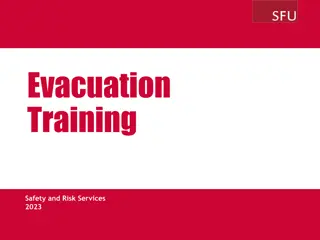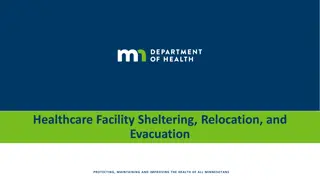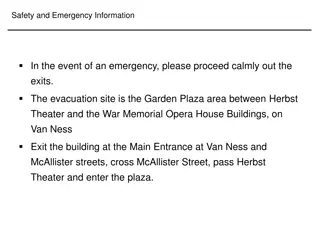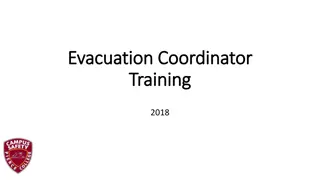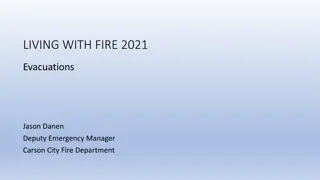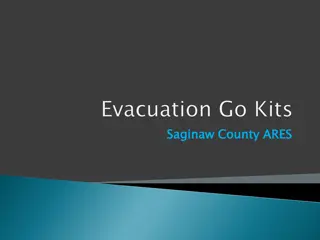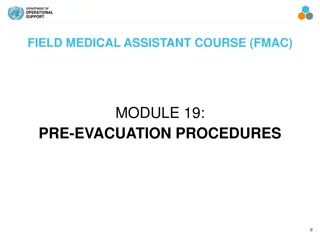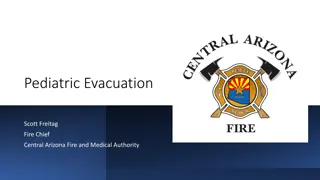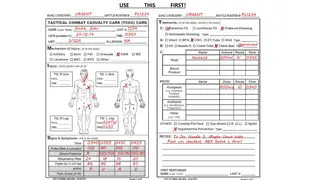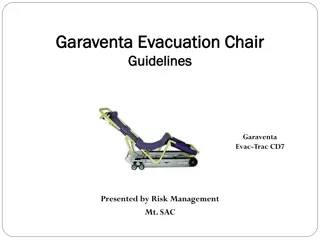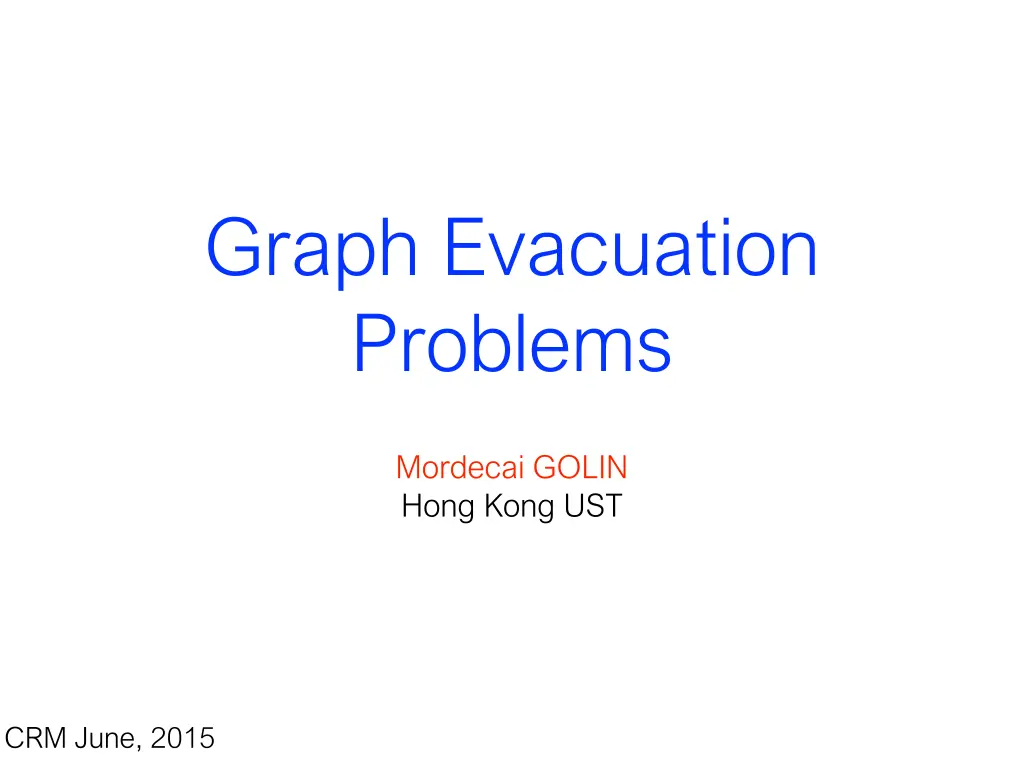
Solving Evacuation Problems in Dynamic Flow Networks
Explore graph-based evacuation strategies in emergency scenarios through dynamic flow networks, aiming to efficiently evacuate individuals to safety during crises. This involves designing effective evacuation protocols based on flow capacities, transit times, and emergency exits. Specialized algorithms address challenges posed by congestion and time constraints in evacuation scenarios, optimizing flow dynamics for swift and safe evacuations.
Download Presentation

Please find below an Image/Link to download the presentation.
The content on the website is provided AS IS for your information and personal use only. It may not be sold, licensed, or shared on other websites without obtaining consent from the author. If you encounter any issues during the download, it is possible that the publisher has removed the file from their server.
You are allowed to download the files provided on this website for personal or commercial use, subject to the condition that they are used lawfully. All files are the property of their respective owners.
The content on the website is provided AS IS for your information and personal use only. It may not be sold, licensed, or shared on other websites without obtaining consent from the author.
E N D
Presentation Transcript
Graph Evacuation Problems Mordecai GOLIN Hong Kong UST CRM June, 2015
Joint Work with Guru Prakash Arumugam John Augustine Di Chen Siu-Wing Cheng Yuya Higashikawa Naoki Katoh Guanqun Ni Bing Su Prashanth Srikanthan Yinfeng Xu 2
Outline Dynamic Flow Networks Congestion in Dynamic Flows Evacuation Flows Problem Definitions Known Results Example Algorithm 1: k-Sink Evacuation on a Path Example Algorithm 2: 1-sink Min-Max Regret Evacuation on a Path with uniform capacity Open Problems 3
Evacuating Graphs Graph G=(V,E) represents structure Vertices are rooms, Edges are Hallways Vertices are Buildings, Edges are roads Edge weight ?e is transit time on edge Edge capacity ceis width Special vertices (sinks) are emergency exits In case of emergency, want to evacuate everybody to exits as quickly as possible Problem: Design Good Evacuation Protocols Often Approached via Dynamic Flow Networks
Dynamic Flow Networks G=(V,E) Edges have travel times ?e and capacities ce Distinguished source s and sink t Max Flow Over Time Problem (input T) How much flow can be pushed from s to t in time T? Ford Fulkerson (1958) Not polynomial (Constructs Static Max-Flow each timestep) t s Quickest Flow Problem (input W) How quickly can W items be moved from s to t? Burkard, Dlasks and Klinz (1993) Strongly Polynomial (uses parametric search) Quickest Transhipment Problem Like QF Problem but Multiple Sources/Sinks (with fixed supply/demands) Hoppe & Tardos (2000) Strongly Polynomial (but uses sub modular optimization)
Edges have Capacities Original Flow Model is static. Doesn t model time Time required is function of both transit times and capacities ceis edge capacity ( width ) At most ce people can enter edge e=(u,v) in one time unit. They travel together as a group on e If more than ce people at u, remainder need to wait to enter e ?e is time for one group to traverse edge Start with W people at u How much time does take them all to reach v? 13 v u c=2 ?=3
t=0 13 v u c=2 ?=3
t=1 11 2 v u c=2 ?=3
t=2 9 2 2 v u c=2 ?=3
t=3 7 2 2 2 v u c=2 ?=3
t=4 5 2 2 4 v u c=2 ?=3
t=5 3 2 2 6 v u c=2 ?=3
t=6 1 2 2 8 v u c=2 ?=3
t=7 1 2 10 v u c=2 ?=3
t=8 1 12 v u c=2 ?=3
t=9 13 v u c=2 ?=3
t=9 13 v u c=2 ?=3 13 items split into g = 13/2 = 7 groups First group reached v at time t= ?=3 Last group reached v at time t= 3 +g -1=9 Discrete Model W people, Capacity c integral, Transit time ? All edge transit times integral Requires W/c + ?-1 time to move everyone from u to v Default for this talk Continuous Model W units of non-quantized fluid. Fluid flows continuously c is rate: amount that can enter e in one unit of time Requires W/c+ ?-1 time to move all fluid from u to v
Outline Dynamic Flow Networks Congestion in Dynamic Flows Evacuation Flows Problem Definitions Known Results Example Algorithm 1: k-Sink Evacuation on a Path Example Algorithm 2: 1-sink Min-Max Regret Evacuation on a Path with uniform capacity Open Problems
Congestion Effects A major complication with dynamic flows is that they introduce congestion effects that can slow down transport time 16 9 u w ?1=3 c1=8 ?2=5 c2=3 v 19
Congestion Effects 9 16 u w ?1=3 c1=8 ?2=5 c2=3 v 20
Congestion Effects 8 3 3 3 8 t=3: first 8 items from u reach v which is empty. First 3 items pass through but others need to wait because c1<c2 Congestion occurs. u w ?1=3 c1=8 ?2=5 c2=3 v 21
Congestion Effects 13 3 3 3 3 t=3: first 8 items from u reach v which is empty. First 3 items pass through but others need to wait because c1<c2 Congestion occurs. u w ?1=3 c1=8 ?2=5 c2=3 v t=4 22
Congestion Effects 10 3 3 3 3 3 t=3: first 8 items from u reach v which is empty. First 3 items pass through but others need to wait because c1<c2 Congestion occurs. u w ?1=3 c1=8 ?2=5 c2=3 v t=4 t=5 23
Congestion Effects 7 3 3 3 3 6 t=3: first 8 items from u reach v which is empty. First 3 items pass through but others need to wait because c1<c2 Congestion occurs. u w ?1=3 c1=8 ?2=5 c2=3 v t=4 t=5 t=6 24
Congestion Effects 4 3 3 3 3 9 t=3: first 8 items from u reach v which is empty. First 3 items pass through but others need to wait because c1<c2 Congestion occurs. u w ?1=3 c1=8 ?2=5 c2=3 v t=4 t=5 t=6 t=7 25
Congestion Effects 1 3 3 3 3 3+9 t=3: first 8 items from u reach v which is empty. First 3 items pass through but others need to wait because c1<c2 Congestion occurs. u w ?1=3 c1=8 ?2=5 c2=3 v t=4 t=5 t=6 t=7 t=8 26
Congestion Effects 1 3 3 3 6+9 t=3: first 8 items from u reach v which is empty. First 3 items pass through but others need to wait because c1<c2 Congestion occurs. u w ?1=3 c1=8 ?2=5 c2=3 v t=4 t=5 t=6 t=7 t=8 t=9 27
Congestion Effects 16+9 t=3: first 8 items from u reach v which is empty. First 3 items pass through but others need to wait because c1<c2 Congestion occurs. u w ?1=3 c1=8 ?2=5 c2=3 v t=4 t=5 t=6 t=7 t=8 t=9 t=13: Last item arrives at w 28
Congestion Effects 9 16 u w Congestion occurs because c1<c2 Full Evacuation at t=13 ?1=3 c1=8 ?2=5 c2=3 v 29
Congestion Effects 9 16 u w Congestion occurs because c1<c2 Full Evacuation at t=13 ?1=3 c1=8 ?2=5 c2=3 v 16 36 u w ?1=3 c1=8 ?2=5 c2=9 v 30
Congestion Effects 9 16 u w Congestion occurs because c1<c2 Full Evacuation at t=13 ?1=3 c1=8 ?2=5 c2=3 v 8 8+9 9 9 9 u w t=3: first 8 items from u reach v which still contains 9 items => Congestion occurs. ?1=3 c1=8 ?2=5 c2=9 v 31
Congestion Effects 9 16 u w Congestion occurs because c1<c2 Full Evacuation at t=13 ?1=3 c1=8 ?2=5 c2=3 v 16+36 u w t=3: first 8 items from u reach v which still contains 9 items => Congestion occurs. t=12: Last item arrives at w ?1=3 c1=8 ?2=5 c2=9 v 32
Congestion Effects 9 16 u w Congestion occurs because c1<c2 Full Evacuation at t=13 ?1=3 c1=8 ?2=5 c2=3 v 16 36 Congestion occurs because v not empty when first group arrives from u u w ?1=3 c1=8 ?2=5 c2=9 v Full Evacuation at t=12 33
Congestion Effects 9 16 u w Congestion occurs because c1<c2 Full Evacuation at t=13 ?1=3 c1=8 ?2=5 c2=3 v 16 36 Congestion occurs because v not empty when first group arrives from u u w ?1=3 c1=8 ?2=5 c2=9 v Full Evacuation at t=12 16 18 u w ?1=3 c1=8 ?2=5 c2=9 v 34
Congestion Effects 9 16 u w Congestion occurs because c1<c2 Full Evacuation at t=13 ?1=3 c1=8 ?2=5 c2=3 v 16 36 Congestion occurs because v not empty when first group arrives from u u w ?1=3 c1=8 ?2=5 c2=9 v Full Evacuation at t=12 8 8 9 9 t=3: first 8 items from u reach v which is empty still contains 9 items => NO Congestion occurs. u w ?1=3 c1=8 ?2=5 c2=9 v 35
Congestion Effects 9 16 u w Congestion occurs because c1<c2 Full Evacuation at t=13 ?1=3 c1=8 ?2=5 c2=3 v 16 36 Congestion occurs because v not empty when first group arrives from u u w ?1=3 c1=8 ?2=5 c2=9 v Full Evacuation at t=12 16+18 t=3: first 8 items from u reach v which is empty still contains 9 items => NO Congestion occurs. t=9: Last item arrives at w u w ?1=3 c1=8 ?2=5 c2=9 v 36
Congestion Effects 9 16 u w Congestion occurs because c1<c2 Full Evacuation at t=13 ?1=3 c1=8 ?2=5 c2=3 v 16 36 Congestion occurs because v not empty when first group arrives from u u w ?1=3 c1=8 ?2=5 c2=9 v Full Evacuation at t=12 16 18 Items at u pass through v with No Congestion occuring Full Evacuation at t=9 u w ?1=3 c1=8 ?2=5 c2=9 v Analysis of Flow/Evacuation times must include congestion!! Can be very complicated! 37
Outline Dynamic Flow Networks Congestion in Dynamic Flows Evacuation Flows Problem Definitions Known Results Example Algorithm 1: k-Sink Evacuation on a Path Example Algorithm 2: 1-sink Min-Max Regret Evacuation on a Path with uniform capacity Open Problems
Evacuation is NOT Flow In Flow, different people from same vertex can follow different paths In Evacuation, want signs at vertices pointing this way out => Each vertex has unique evacuation edge. Every person reaching that vertex must follow the evacuation edge to next vertex Evacuation edges partition vertices into directed forests moving toward sinks
Graph Evacuation Problems Input: Graph G=(V,E) ?e, ce: transit times and capacities for each edge wv:# of people starting on vertex v Sinks: Either fixed set K V of sinks or a number k of sinks allowed Output: An Evacuation Protocol that minimizes maximum evacuation time Evacuation Protocol A unique evacuation edge for each vertex If input is k, a set K V of sinks with |K|=k Maximum Evacuation time The evacuation time of a vertex is the earliest time by which ALL items from that vertex have reached a sink. Maximum evacuation time is the maximum evacuation time over all vertices
Graph Evacuation Problems: Variations Type of graph G: Path, Tree, General, . For general G and k>1 problem is NP-Complete because it solves k- Center (if ce set to be large) Sink Input: Actual Sinks vs # of sinks Discrete vs Continuous flow Fleischer, Tardos (1998). D and C Dynamic Flow problems can often be solved using same algorithm Sink locations: anywhere or only on vertices ce: uniform (all the same) vs general (arbitrary) Min-Max vs Min-Max Regret Robust solutions. MMR allows wv, # of people on vertex, to be a range rather than a number. Find best solution for all allowable scenarios
Outline Dynamic Flow Networks Congestion in Dynamic Flows Evacuation Flows Problem Definitions Known Results Example Algorithm 1: k-Sink Evacuation on a Path Example Algorithm 2: 1-sink Min-Max Regret Evacuation on a Path with uniform capacity Open Problems 42
Known Results Min-max cost (DISCRETE/CONTINUOUS) General capacity Uniform capacity 1-sink O(n) [2] O(n log2n) [7] Poly? k-sink 1-sink O(n) k-sink O(kn) [6] O(k2 n log3n) [3] NP-Hard O(kn log2n) [2] O(k2 n log4n) [3] NP-Hard Path O(n log n) [4] Poly? Tree General graph Min-max regret cost (DISCRETE/CONTINUOUS) General capacity Uniform capacity 1-sink k-sink 1-sink k-sink O(n log n) [5,9] O(n2log2n) [4] None O(kn3 logn) [1] Path None Tree None General graph
References [1]G.P. Arumugam, J. Augustine, M.J. Golin and P. Srikanthan, A Polynomial Time Algorithm for Minimax- Regret Evacuation on a Dynamic Path , arXiv:1404.5448, 2014 [2] G.P. Arumugam, J. Augustine, M.J. Golin and P. Srikanthan, Evacuation on Dynamic Paths with General Edge Capacities , document in preparation (2015) [3] Di Chen and M.J. Golin, Optimal Sink Location Problems in Dynamic Tree Networks , document in preparation (2015) [4]Y. Higashikawa, M. J. Golin and N. Katoh, Minimax Regret Sink Location Problem in Dynamic Tree Networks with Uniform Capacity , Proc. WALCOM 2014, LNCS 8344, pp. 125-137, 2014. [5]Y. Higashikawa, J. Augustine, S. W. Cheng, N. Katoh, G. Ni, B. Su and Y. Xu, Minimax Regret 1-Sink Location Problem in Dynamic Path Networks , Theoretical Computer Science, 2014. [6]Y. Higashikawa, M. J. Golin and N. Katoh, Multiple Sink Location Problems in Dynamic Path Networks , Theoretical Computer Science (to appear) 2015. [7]S. Mamada, T. Uno, K. Makino and S. Fujishige, An O(n log2 n) Algorithm for the Optimal Sink Location Problem in Dynamic Tree Networks , Discrete Applied Mathematics, 154(16), pp. 2387-2401, 2006. [8]G. Ni, Y. Xu and Y. Dong, Minimax regret k-sink location problem in dynamic path networks , Proc. AAIM 2014 [9]H. Wang, Minmax Regret 1-Facility Location on Uncertain Path Networks , Proc. ISAAC 2013, LNCS 8283, pp. 733-743, 2013.
Outline Dynamic Flow Networks Congestion in Dynamic Flows Evacuation Flows Problem Definitions Known Results Example Algorithm 1: k-Sink Evacuation on a Path Example Algorithm 2: 1-sink Min-Max Regret Evacuation on a Path with uniform capacity Open Problems
K-Sink Evacuation on a Path Given a path, associated values ce,?e,Wv and k, # of sinks, Find a partition into k-subpaths and a sink for each subpath, that minimizes the maximum evacuation time over all subpaths.
1-Sink Evacuation Notation L(P,x) = Time to evacuate all nodes to left of x on P to x R(P,x) = Time to evacuate all nodes to right of x on P to x (P,x) = max( L(P,x), R(P,x)) = Time to evacuate all nodes on P to x 1(P) = min{x P} (P,x) = min evacuation time for P with one sink
1-Sink Evacuation Example Original Input: X is the sink location that minimizes Maximum Evacuation Time Note: Min evac-time sink location is NOT an original vertex. Can modify problem definition to require sink to be a vertex Algorithms remain almost the same
k-Sink Evacuation Notation Given Path P and integer k P ={P1, P2, , Pk} is a partition of P into k-subpaths Given P, the evacuation time of P is max ( 1(P1), 1(P2), , 1(Pk)) Want to find k(P) = minP( max ( 1(P1), 1(P2), , 1(Pk)) ) = Min k-sink evacuation time for P
Algorithm Development Sketch 1. Formulae for L(P,x) and L(P,x) 2. => O(|P|) Algorithm for L(P,x), L(P,x) 3. => O(|P| log |P|) Algorithm for 1(P) 4. => O(|P| log |P|) Algorithm that > 0 tests whether k(P) 5. => O(k|P| log2 |P|) Algorithm for k(P)


